Matador Network's Blog, page 125
September 5, 2024
In Lake Tahoe, Nothing Pairs Better With Big Fun Than Great Food

Mark Twain famously called Lake Tahoe “the fairest picture the whole earth affords.” Take one look and you’ll see why. At 22 miles long and 12 miles wide, Lake Tahoe is a kingdom of cobalt water straddling the line between California and Nevada. The towering peaks of the Sierra Nevada circle like a hug, casting their reflection into the lake’s mirror-like surface to create the illusion that the mountains, water, and sky are one.
All that beauty is perhaps best experienced from the South Shore of Lake Tahoe, where jaw-dropping views meet exciting activities and excellent restaurants. There, the concept of a combo meal is one that starts and ends with adventure, be it an epic pre-lunch hike or a post-dinner waterfront concert. So be sure to bring an appetite for food and fun on your next trip to the South Shore of Lake Tahoe. Here’s what to seek out when you arrive.
Hit the beach, then hit The Grove
Photo: Rachid Dahnoun/Lake Tahoe Visitors Authority
Everyone is invited to celebrate the great outdoors on the South Shore of Lake Tahoe. Near Camp Richardson Resort and Marina, El Dorado Beach offers a beach wheelchair on a first-come-first-serve basis, and you’ll find wheelchair-accessible pathways at the Pope-Baldwin Bike Path and the Rainbow Trail at Taylor Creek Visitor Center.
Just down the shore from El Dorado Beach, all are also welcome at The Grove restaurant at Camp Richardson. While the adults at the table peruse the signature cocktail list and choose between creative plates like miso salmon and fried chicken with beignets, kids can tackle the word search that comes with their menu before chowing down on classics like grilled cheese and buttered noodles. Whatever you order, the indoor and outdoor dining options will keep the killer waterfront views going.
The Grove: 1900 Jameson Beach Rd, South Lake Tahoe, CA 96150
Bike up an appetite for Brooks’ Bar at Edgewood
Photo: Edgewood Tahoe Resort
Van Sickle Bi-State Park is the place to head for mountain biking. Located just uphill of the casinos and restaurants in Stateline, the park is jointly operated by the states of California and Nevada. The trails here are easy to access, traveling through timber and past colossal rock formations with dramatic lake views. The trails are open to hikers too, and in winter it’s a popular spot for cross-country skiing and snowshoeing.
When you’ve had your fill of the park, Brooks’ Bar & Deck at Edgewood on Edgewood Tahoe’s stunning golf course is calling. Both indoor and outdoor seating are available to showcase lake and mountain views while you sip handcrafted cocktails and dig into fresh seasonal options like salads, tacos, and sandwiches. And if you want to follow drinks at Brooks’ Bar with a decadent dinner, head to Wolf by Vanderpump at Harveys Lake Tahoe, just a few minutes away.
Pro tip: Lake Tahoe’s trails are most rewarding on weekdays and during shoulder seasons when they’re quieter and less trafficked. (Sunny late spring and early fall days happen to be an excellent time to visit Brooks’ Bar & Deck, too.) Help preserve Tahoe’s natural beauty by keeping to dedicated pathways and leaving no trace behind.
Brooks’ Bar & Deck: 180 Lake Pkwy, Stateline, NV 89449
Take it easy at The Hangar after an epic hike
Photo: Rachid Dahnoun/Lake Tahoe Visitors Authority
If you’ve come to Lake Tahoe seeking a challenge, you’ll have myriad opportunities. The region’s highest point is located on the South Shore of Lake Tahoe in the nearly 64,000-acre Desolation Wilderness, where the 9,738-foot Mount Tallac soars above the lake’s sapphire waters. It’s a 10-mile hike, but the commanding views of the lake, mountains, and iconic sights like Emerald Bay and Fannette Island make it all worthwhile.
After you’ve touched the top of Mount Tallac, reward yourself with an ice-cold beer at lower elevations. The Hangar Taproom and Bottle Shop offers 30 rotating taps and an extensive bottle and can collection. You’ll also find corn hole, bocce, and a patio to unwind at this dog-friendly favorite.
The Hangar: 2401 Lake Tahoe Blvd, Suite B, South Lake Tahoe, CA 96150
Après at South Lake Brewing Libation Lodge
Photo: Ryan Finn/South Lake Brewing Co
There’s nothing like a pint after a day on the slopes. That goes double if you’ve spent your turns exploring the 4,800 skiable acres at Heavenly Mountain Resort, Lake Tahoe’s tallest. And there’s no place to grab a post-schuss brew like South Lake Brewing Libation Lodge. Located right across from Heavenly Village, the taproom is operated by South Lake Brewing Company, the area’s largest craft brewery. Look forward to a full tap list including beer and wine, elevated pub fare, and a grab-and-go fridge stocked with craft beer.
Fun fact: Accessibility means more than just a short commute to the South Lake Brewing Libation Lodge for the folks at Heavenly. In winter, the resort offers adaptive ski and snowboarding lessons with personalized instruction for visitors with disabilities; the gondola is wheelchair-accessible, and snow-accessible wheelchairs are available at the top.
South Lake Brewing Libation Lodge: 4000 Lake Tahoe Blvd STE 26, South Lake Tahoe, CA 96150
Do dinner at Elements, then a show
Photo: Brian Walker/Lake Tahoe Visitors Authority
In Stateline, casinos glimmer against the backdrop of the wilderness. This is the best place in Lake Tahoe for nightlife — check out spots like Harrah’s Lake Tahoe and Golden Nugget Hotel & Casino Lake Tahoe, which have numerous nightclubs, bars, and restaurants within walking distance.
Harveys Lake Tahoe is home to the Lake Tahoe Summer Concert Series. In recent years, headliners have included the Foo Fighters and Rod Stewart. A few blocks away, the new Tahoe Blue Event Center is the permanent home of the Tahoe Knight Monsters professional hockey team. The venue has also hosted performers such as Adam Sandler and Colin Jost.
Before you head into the theater, soak in waterfront views while you enjoy Mexican-American fusion dishes at Elements Eatery & Bar. The restaurant celebrates diverse flavors with handmade tortillas, smash burgers, and craft cocktails. Alternatively, after a long night out, you can start the day off right at Elements, with breakfast options like chilaquiles, huevos rancheros, and horchata french toast.
Elements: 3310 Lake Tahoe Boulevard, South Lake Tahoe, CA 96150
Get your fresh catch fried up at MacDuff’s
Photo: Brian Walker Photography/Lake Tahoe Visitors Authority
You’ll find a wealth of free concerts on the South Shore of Lake Tahoe, too. Some of the most popular include the Live at Lakeview summer concert series at El Dorado Beach, free summer lawn concerts at Valhalla at Lake Tahoe, and the Heavenly Village Summer Concert Series on Friday and Saturday nights.
Grab dinner before the show at MacDuff’s Public House, which serves up crowd-pleasing favorites like fish and chips, burgers, and pasta. If you went fishing with a local outfitter like Mile High Fishing Charters, they’ll even prepare your catch for you.
MacDuff’s: 3310 Lake Tahoe Boulevard, South Lake Tahoe, CA 96150
Wind down with low-and-slow barbecue at Fox & Hound
Photo: Lake Tahoe Visitors Authority
Lake Tahoe is so clear that depths of up to 75 feet are visible from the surface. Kayaks and SUPs can be rented at most beaches on the South Shore of Lake Tahoe, so you can swish peacefully across the water and peer down at the world below. If you’d rather let someone else do the driving, book a daytime or dinner cruise on the beloved M.S. Dixie II Paddlewheeler, which departs from Zephyr Cove Resort.
For a day of laid-back family fun in the area during winter, head to nearby Tube Tahoe. The price of admission includes tube rental, and their slopes are over 500 feet long. But whatever the season and however you spend the day, make sure it includes a plate of barbecue from Fox & Hound Smokehouse Grill & Bar. The eatery is perched more than 7,000 feet above sea level to offer stellar views of the Carson Valley. If you’re really hungry, try the burger challenge — finish the whopping four-pound monster in 60 minutes or less and it’s free.
With so many food and fun pairings, you might not get to try everything during a single visit — but that’s okay. The South Shore of Lake Tahoe will welcome you when you come back for seconds.
Fox & Hound: 237 Tramway Dr, Stateline, NV 89449 
Experience the Reciprocity of Aloha on Oʻahu: Activities to Enrich Your Next Hawaiʻi Trip
 Experience the Reciprocity of Aloha on Oʻahu: Activities to Enrich Your Next Hawaiʻi Trip
Experience the Reciprocity of Aloha on Oʻahu: Activities to Enrich Your Next Hawaiʻi TripBy: Sarah Etinas
Photo: Hawaii Tourism Authority/Heather Goodman
“Aloha, welcome to Hawaiʻi.” That’s how nearly every visitor is greeted on arrival to the islands, but the Hawaiian word “aloha” means much more than “hello” and “goodbye.” It’s a term with deep roots in Native Hawaiian culture, and there is, without a doubt, a reciprocal aspect to “aloha” — often encompassed by the phrase “aloha spirit” — the idea that the good you put into the world will come back to you.
There are many ways visitors can embody aloha and leave a positive impact, like volunteering or taking the time to learn about Native Hawaiian history and culture. Get some inspiration for your next Oʻahu visit with these activities that are equal parts fun and fulfilling.

This post is proudly produced in partnership with The Hawaiian Islands.
Take to the Waves with Moniz Family Surf Family ready to surf
The earliest evidence of surfing can be traced back to 12th-century Polynesia. Called heʻe nalu, or wave sliding, surfing was a sport for everyone in Hawaiian society, regardless of gender or social standing.
But with the arrival of missionaries and their Western influence in the early 1800s, surfing was looked down on. For decades thereafter, heʻe nalu seemed to be an activity of the past — until three Hawaiian princes attended St. Matthews Military School in San Mateo, CA, and introduced surfing in 1885. Then five-time Olympic medalist Duke Kahanamoku arrived on the scene. He won silver and gold medals for swimming at the 1912, 1920, and 1924 Olympic Games and embarked on a world tour to showcase both his swimming and surfing skills, helping to revive the wave-riding sport.
Take to the waves yourself with Moniz Family Surf in Waikīkī, which was a favorite place for Hawaiian royalty to flex their surf skills. Run by a longtime local surf family, this beloved surf school offers expert instruction to help you ride the waves. Choose between a private or a small group lesson (up to four people) for your introduction to this quintessential island pastime.
Book NowPhoto credits: Hawaii Tourism Authority/Ben Ono Learn About Traditional Hawaiian Life in Waimea Valley Traditional Kauhale Lei weavingWith its thriving tropical plants and 45-foot waterfall, Waimea Valley is one of the best places to learn about the ahupuaʻa, or traditional land divisions. In fact, according to Richard Pezzulo, Executive Director of Waimea Valley, Hiʻipaka LLC, “it’s the only fully intact ahupuaʻa on Oʻahu that’s interpreted [for] the public.”
At the valley, wander around Kāhiko o Kauhale, an immersive exhibit with seven traditional Hawaiian living sites. You’ll notice how Native Hawaiians cared for the land with aloha by using every part of a plant. Coconut fibers were woven to make tools and stringed instruments, like the ʻukulele, coconut shells served as kitchenware, and coconut leaves were used to weave baskets and thatched roofs. Nothing went to waste. Authenticity is the site’s standout feature, says Pezzulo, noting that it was “reconstructed on the footprints of a genuine kauhale (village) from centuries ago.”
Pezzulo also encourages visitors to engage with staff and artisans as they tour the valley’s three key cultural sites: Hale Hōʻike, Kauhale, and Kahua Pāʻani. If you can recite the values you learned at the end of your tour, you’ll be rewarded not only with new insights into Hawaiian cultural life but also a Hoʻokipa ambassador certificate and pin.
Book NowPhoto credits: Waimea Valley, Hi’ipaka LLC and Hawaii Tourism Authority/John Hook Dig into Native Hawaiian History at the Bishop Museum Hawaiian Hall Museum exteriorThe Bishop Museum showcases the largest collection of Hawaiian and Pacific cultural artifacts and natural history specimens in the world, making it a fantastic place to delve into the different time periods of Native Hawaiian history. Your journey begins in Pacific Hall, where you’ll see model canoes and learn about the Polynesians who braved the trans-Pacific journey to become the first settlers of Hawaiʻi, arriving between 1000 and 1200 CE.
Polynesian voyages to Hawaiʻi mysteriously stopped around 1300 CE, so Hawaiian culture and society developed on its own. In Hawaiian Hall, learn all about the Native Hawaiian moʻolelo (stories and legends), akua (gods), and beliefs, along with how the people lived their daily lives.
Until the late 18th century, each Hawaiian Island lived independently with frequent battles between their rulers. But between 1790 and 1810, King Kamehameha I fought to unite all the Hawaiian Islands and successfully establish the Kingdom of Hawaiʻi, which thrived for nearly a century after that. Peek at this part of history in the Bishop Museum’s Abigail Kinoiki Kekaulike Kāhili Room, where you’ll see portraits and artifacts of the most revered and beloved aliʻi (chiefs).
Book NowPhoto credits: Bishop Museum and Hawaii Tourism Authority/Tor Johnson Learn to Mālama ʻĀina at Kualoa Ranch Group touring Kualoa Ranch Moli´i FishpondTucked away in the verdant Koʻolau Mountains, the locally owned Kualoa Ranch Private Nature Reserve offers several nature-inspired tours. In particular, the Kualoa Grown Tour and the Mālama Experience Tour give glimpses of the reciprocal value of aloha through mālama ʻāina.
On the Kualoa Grown Tour, you’ll learn about traditional Hawaiian food systems and farming practices and visit the historic Moliʻi Fishpond. As one of the four historic Hawaiian fishponds still on Oʻahu, this is where Hawaiians farmed and caught their moi (threadfish), awa (milkfish), and ʻamaʻama (mullet).
The hands-on Mālama Experience Tour changes based on the land’s needs, so your activity will be shared upon arrival. You may mālama ʻāina by working in the loʻi (taro fields), weeding the māla lāʻau lapaʻau (Hawaiian medicinal plant garden), or repairing the roofs of traditional Hawaiian thatched homes.
Book NowPhoto credits: Hawaii Tourism Authority/Ben Ono and Hawaii Tourism Authority/Vincent Lim Get Into the Dirt with Kākoʻo ʻŌiwi Volunteer planting taroKalo (taro) has a long history in Hawaiʻi. According to Hawaiian moʻolelo (legends), the Hawaiian goddess Hoʻohōkūkalani became pregnant, but sadly, the baby, Hāloa, was stillborn. In her grief, Hoʻohōkūkalani buried Hāloa and watered him with her tears until a green, heart-shaped sprout appeared: the very first kalo plant.
Horticulturists tell the story of kalo a little differently. Likely introduced to the islands by the first Polynesian voyagers, the species quickly became a Native Hawaiian food staple due to its high nutritional content. Various parts of the plant were pounded into poi, steamed into kūlolo (coconut-taro pudding), and used as a wrapping for laulau (leaf-wrapped protein entree).
Have your own hands-on experience with kalo through the nonprofit Kākoʻo ʻŌiwi in Kāneʻohe. The nonprofit offers thrice weekly workdays in the loʻi where you can get knee-deep in the mud to weed, as well as plant and harvest kalo. As you work, volunteer leaders will share their knowledge of kalo in Native Hawaiian culture, traditional Hawaiian farming practices, and the mountainous Kāneʻohe region.
Book NowPhoto credits: Hawaii Tourism Authority/Heather Goodman Take Care of the Ocean with Mālama Maunalua Community hukiAt least once a month, this Hawaiʻi Kai nonprofit hosts a community huki — or “pulling” — to remove invasive algae from Oʻahu’s Maunalua Bay. Without intervention, the invasive species would overwhelm the coral reefs, kill native algae communities, and disrupt the bay’s entire marine environment. For almost 20 years, Mālama Maunalua and its 30,000-plus volunteers have cleared four million pounds of invasive algae, continually cleaning the bay and turning the removed algae into soil amendments for local farms.
Oʻahuʻs beauty rejuvenates nearly every visitor. By embracing the true spirit of aloha during your stay, you can give back to the island as much as it gives to you. What could be more rewarding than a travel experience that nurtures both the destination and the traveler? 
From Witchy Cottages to East Coast Mansions, These Are the Top Airbnbs for Halloween in Salem

The seaside city of Salem is one of the most popular places to visit during the spooky season. Yes, you can watch the countless Netflix documentaries and the original Hocus Pocus on repeat in the lead-up to Halloween, but if you’d like an authentic experience, why not put your big boy/girl pants on and stay for a night or two? Most visit Salem to learn about the 1692 witch trials, and numerous guided tours with local historians will take you through 400 years of history and to places like the Old Witch Jail and the Salem Witch Trials Memorial. The sad history of Salem is juxtaposed with celebration in October. This is the city’s busiest time of year. As you’d expect, Salem goes all in around Halloween. There are street performers, fancy dress competitions, and themed pub crawls. So, if you’re planning a fall trip, do so as far in advance as possible. To help you out, Matador has looked through Salem’s top Airbnbs and selected some of the highest-rated options for solo travelers, couples, and families. Some are a little witchy. Others are examples of East Coast architecture at its finest. These are the top 10 Salem, Massachusetts, Airbnb rentals for Halloween and all year round.
We hope you love the Salem Massachusetts Airbnb rentals we recommend! Just so you know, Matador may collect a small commission from the links on this page if you decide to book a stay. Listed prices are accurate as of the time of publication.
3-bedroom called The Creaky Cauldron where all witches and wizards are welcome Photo: Airbnb
Photo: Airbnb Photo: Airbnb
Photo: Airbnb Photo: AirbnbSee more photos
Photo: AirbnbSee more photosThere’s a real mix of Airbnb styles in Salem. Many are embracing the city’s spooky reputation with year-round witch-themed decor ranging from tacky to more authentic. This three-bedroom, called The Creaky Cauldron, is playful and perfect for those visiting with little witches and wizards. It’s also within the top 10 percent of Airbnb homes, a new rating system launched by the platform to help guests find Airbnbs with outstanding reviews. A Harry Potter theme floods through every room in the centrally located rental, and past guests remark on the intricate details of the styling and their immersive experience. It’s a five-minute walk from downtown Salem and all the attractions. It is worth noting that during October, street parking in the city is for residents only, and this rental comes with one parking spot. During the rest of the year, parking is plentiful.
Eight guests, three bedrooms
Price: $650 per night
 Photo: Airbnb
Photo: Airbnb Photo: Airbnb
Photo: Airbnb Photo: AirbnbSee more photos
Photo: AirbnbSee more photosWithin the top one percent bracket on Airbnb is this comfortable one-bedroom condo with a charming porch and views of the Salem Common. This rental would ideally suit a couple or small family as there’s only one private bedroom with a king-sized bed. The other sleeping arrangement is an amply-sized queen in the living room. The kitchen with a farmhouse table is separate through, so early mornings shouldn’t be an issue if the living room is occupied. And don’t forget the porch with outdoor seating — a perfect place for a morning breakfast while watching the goings on of Salem. The host says it’s definitely not the oldest house in the city, but it does date back to 1913, so don’t be surprised if something goes bump in the night — although there are only positive reviews and no mention of creepy goings on.
Four guests, one bedroom
Price: $253 per night
 Photo: Airbnb
Photo: Airbnb Photo: Airbnb
Photo: Airbnb Photo: AirbnbSee more photos
Photo: AirbnbSee more photosThis two-bedroom, one-bathroom apartment is on the third floor of the 1774 Josiah Woodbury House on Broad Street. It’s one of the oldest standing structures in the city, and now you can stay and enjoy its splendid views and sunsets across the rooftops of Salem. Its location on Broad Street also puts it within a five or so-minute walk from the must-see historic houses, tours, the waterfront, and, importantly, the MBTA station with a service to Boston. Salem is pedestrian-friendly, and keep in mind that parking in peak season can be tricky, so opting for the train is a smart idea. Outside, there’s a shared garden with seating and a gas fire pit. The owners live on the first floor, and previous guests say they are very welcoming and helpful with recommendations on where to eat and what to do (and what to avoid) in the city.
Five guests, two bedrooms
Price: $550 per night
 Photo: Airbnb
Photo: Airbnb Photo: Airbnb
Photo: Airbnb Photo: AirbnbSee more photos
Photo: AirbnbSee more photosLooking at Airbnb listings in Salem feels like the battle of the oldest building, and this apartment might win out. Another rental within Airbnb’s top 10 percent, the two-bedroom is situated in a building dating back to 1710. It was built by a shoemaker named Jonathan Archer, and while the core of the house remains unchanged, it has undergone renovations and additions throughout the centuries. Today, the building is split into rentals and the apartment has all the mod-cons you’d expect from a luxury Airbnb of this caliber. There’s smart TV entertainment, an EV charger, lightning-fast WiFi, and a modern workstation.
Seven guests, two bedrooms
Price: $834 per night
 Photo: Airbnb
Photo: Airbnb Photo: Airbnb
Photo: Airbnb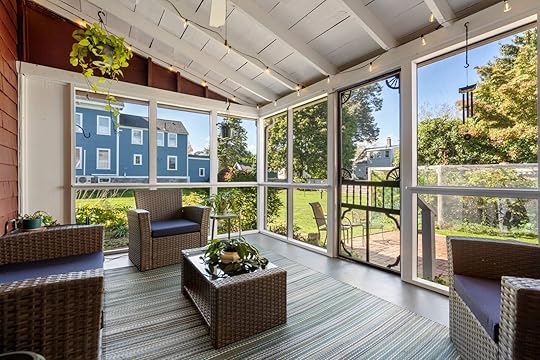 Photo: AirbnbSee more photos
Photo: AirbnbSee more photosAnother historic home, this Airbnb was built in 1824 and is located in the heart of Salem, just a short walk from the city’s most popular attractions. The Salem Witch House is just a few blocks away, and the Peabody Essex Museum is also within walking distance. There are three bedrooms: the first is a spacious room with a king-size bed, the second has a queen-size bed and a small sitting area, and the third has a twin bed and a pull-out sofa bed, making it ideal for families or groups of friends. In addition to having the entire family home to yourself, there are the added benefits of a fenced yard and off-street parking.
Eight guests, three bedrooms
Price: $326 per night
 Photo: Airbnb
Photo: Airbnb Photo: Airbnb
Photo: Airbnb Photo: AirbnbSee more photos
Photo: AirbnbSee more photosThis is one of the prettiest Airbnbs I’ve found in Salem. The two-bedroom bohemian-chic apartment is steps from Salem Common, one of the filming locations of Hocus Pocus and a hub for community events throughout the year. In October, the home’s neighborhood transforms with the streets coming alive with parades, and you’ll have a front-row seat from the Airbnb’s private patio. There are two bedrooms, one spacious master and a second with two twin beds. The living room has a brand new, queen-sized sofa bed if you need additional space.
Six guests, two bedrooms
Price: $715 per night
 Photo: Airbnb
Photo: Airbnb Photo: Airbnb
Photo: Airbnb Photo: AirbnbSee more photos
Photo: AirbnbSee more photosAnother Airbnb for large groups and families, this beloved home is ideal for exploring downtown Salem on foot. It’s located in the McIntire District, a historic neighborhood renowned for its exceptional architecture and preservation efforts. Named after architect Samuel McIntire, the district is home to a collection of well-preserved Federal-style houses, many designed or built by McIntire himself. This Airbnb will transport you back to old Salem, but there’s a modern edge with an updated kitchen with a huge kitchen island, perfect for making breakfast spreads and refurbished bathrooms.
12 guests, six bedrooms
Price: $995 per night
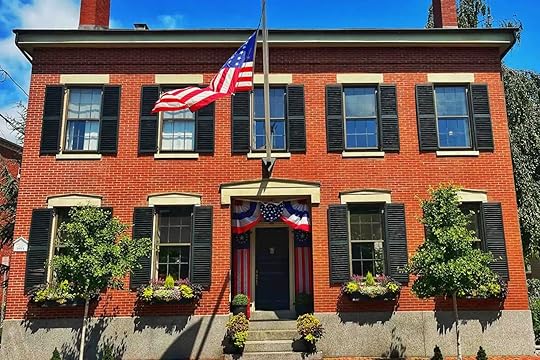 Photo: Airbnb
Photo: Airbnb Photo: Airbnb
Photo: Airbnb Photo: AirbnbSee more photos
Photo: AirbnbSee more photosThis is my top pick for solo travelers and couples. The host states they have the best location in the city, and they are right. Salem’s most prized architecture surrounds this top one percent Airbnb, and it’s steps away from the Witch Museum. The recently renovated suite is on the third floor of a 19th-century historic building. Beautiful antiques and artwork can be found throughout the property, and a charming outdoor patio is the perfect spot after a day walking in Salem.
Four guests, one bedroom
Price: $499 per night
 Photo: Airbnb
Photo: Airbnb Photo: Airbnb
Photo: Airbnb Photo: AirbnbSee more photos
Photo: AirbnbSee more photosThis loft was designed by two local Salem artists and is located on the corner of Salem Common. The converted attic space is within a 19th-century pre-Victorian home and features original floors and there’s a private entrance that leads to the central spiral staircase. Previous guests rave about hosts Vivek and Elizabeth’s communication and kindness. If you’re looking for something small with a lot of character, this is an Airbnb to bookmark.
Four guests, one bedroom
Price: $400 per night
 Photo: Airbnb
Photo: Airbnb Photo: Airbnb
Photo: Airbnb Photo: AirbnbSee more photos
Photo: AirbnbSee more photosSave the most baller for last, why don’t we? If you want to go big, check out this three-story five-bedroom built by one of Salem’s wealthiest families in the 1820s. There are five grand sunny bedrooms, three recently renovated baths, a powder room, a grand dining room fit for royalty, a huge eat-in kitchen with a sprawling deck, and a library — to mention a few of the rooms. The grand house is on fabled Chestnut Street, home to the former house of Judge Jonathan Corwin, who presided over the Salem witch trials and is within walking distance to all the sites. 
Nine guests, five bedroom
Price: $2,000 per night
September 4, 2024
On Northern California’s Tuolumne River, Time Stands Still on a Two-Day Whitewater Rafting Trip

Standing before the Tuolumne Wild and Scenic River in Northern California’s Stanislaus National Forest, preparing to raft it for the first time, I felt a mix of emotions: excitement, anxiety, some fear, a calmness inspired by the natural setting. With my first paddle stroke, those feelings dissipated. Present tense entered the time space as I focused on paddling instructions from my group’s rafting guides. It was in that space that we began our journey into river time.
Led by OARS, a respected outdoor adventure company, our group filled three rafts: six to a boat, plus one guide per boat and three additional supply rafts. For some in the group, it was their first whitewater rafting experience. The water in August, when we embarked on our trip, is more accessible for beginners than it is in spring.
Before us were two days of rapids, leisurely floating, bluebird skies, golden-grassed canyon walls reaching for the sun, and no cell service. There was nothing to do but wait for our guides to tell us when and how to paddle as we ran numerous whitewater rapids on a remote 18-mile stretch of Tuolumne River west of Yosemite National Park.

Photo: Garrett Morrow Prints/Shutterstock
The first few sets of rapids we rafted were relatively approachable. It was like riding a wet rollercoaster down the river. Smiles and cheers lifted in the late morning air. Surveying the scenery between rapids, I kept thinking about the concept of time. A river makes its way through a mountain of rock, existing for eons. But the river knows no time; it only goes, courses, pushes on.
Pulling up to a spit of rock and sand, we stopped for lunch, a spread of deli meats for sandwiches, crunchy potato chips, and fresh-cut fruit. We ate cookies for dessert and lounged with contented bellies in the scant shade. While rafters are welcome to bring their own snacks, OARS provides and prepares all of the food you’ll need during your trip, accounting for any dietary restrictions group members may have.
After lunch, what is perhaps the river’s most anticipated rapid was not far ahead. Clavey Falls is a nine-foot drop over a cascade of frothy whitewater that spills over and around boulders, creating bumps and holes, making lines for the guides to run the rafts down. Looking ahead, we couldn’t see the actual rapid. What we did see was one of the supply rafts and its solo captain disappear into a seeming abyss. We then dropped into the abyss, bouncing to the bottom and feeling a sense of relief that we ran it unscathed.
View this post on InstagramA post shared by OARS – Whitewater Rafting (@oars_rafting)
Below the falls, we pulled over and scrambled out of the rafts and up the rocks. This was the starting point of a side hike to a swimming hole on the Clavey River, a tributary of the Tuolumne. We walked for 10 minutes until we reached a pool with a boulder to jump off. We waded in the pool, keeping cool in the mountain river on a summer day while bugs buzzed.
By the middle of the afternoon, our OARS flotilla paddled up to an expansive sandy beach. This would be our camp for the night. Oaks stretched their arms, providing much needed shade. We set up chairs in a shallow pool, dipping our feet in the cool water as conversation filled the air. Some members of the group swam; others jumped off rocks into the river. Beers flowed, along with non-alcoholic options like kombucha and seltzer waters.
Dinner started with tortilla chips, salsas, and a bowl of freshly made guacamole that our group of ravenous rafters quickly scraped clean. As the guides prepared beef and chicken fajitas with rice and beans, we set up our sleeping arrangements for the night. OARS provides camping gear for rafters (along with a waterproof overnight bag where you can pack a change of river clothes, camp clothes, toiletries, sun protection, electronics, and books or other personal items). Yet not one person in the group opted to use a tent that night. Collectively, we decided to dream under the stars, after enjoying s’mores and laughter.
With no phone screens in sight, I was reminded again about river time. Soon the moon ascended its arc, rising over the ridgeline while stars emerged. Lying in my river camp bed, my eyes grew heavy as I gazed into the blue-ink, star-filled night sky.
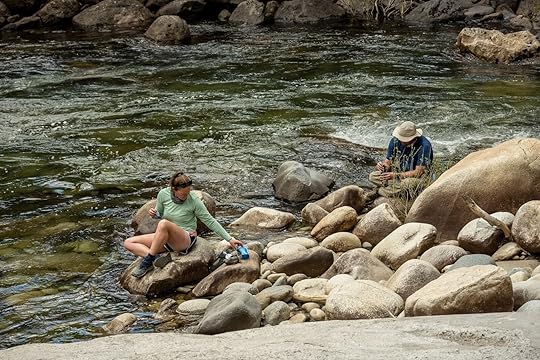
Photo: Kelly vanDellen/Shutterstock
Coffee flowed at 6:30 the next morning. Breakfast was hearty: eggs two ways, scrambled and fried; sausage links; fried potatoes; English muffins; and fresh fruit. The morning passed by in a slow ease. At least one member of the group had brought his rig to fly fish. Others swam or read books. Some of us opted to go on a short hike to see an abandoned gold mine.
Somehow, it was time to eat again. We ate pan-Asian-inspired chicken and cabbage salad, rolled wraps, and munched on chips before filling our OARS-provided water bottles and preparing to depart. We ran more rapids, jumped off boulders, and fell overboard to float on the gentle current. It was a miniscule moment in time but a grand reminder of how momentous life can be.
Next, the Tuolumne Wild and Scenic River — an official designation that comprises 83 miles of the larger river — defined itself for a three-quarter-mile stretch of rapids called Grey’s Grindstone. There’s not a more beautiful river segment to be seen: water meets rock, canyon meets sky, everything glistens and roars while birds soar and fish swim. Such sights are a critical reminder of why we need policy to protect rivers.
View this post on InstagramA post shared by OARS – Whitewater Rafting (@oars_rafting)
I thought of the legacy of David Brower, the famous environmentalist who once said, “We must begin thinking like a river if we are to leave a legacy of beauty and life for future generations.”
Merganser ducks entertained our rafting group as we reached our endpoint, two days on the Tuolumne coming to a close. We spotted a large nest high up in a tree above the river. Then, its maker, a bald eagle perched on a limb. Soon we were all back to doing what we did prior to the trip: turning on our phones and checking in with loved ones.
The river was still there, of course. It was doing what it does, finding its way to wherever. And if you’re fortunate enough to raft it, you realize quickly that the Tuolumne is not just a physical presence. It courses its way into those other places and spaces, the ones within us that we haven’t really figured out yet, but we know they exist. 
Our Gear Editor Found the Best Pair of Waterproof Hiking Boots

For dwellers of the mountains or high desert, a good pair of hiking boots is essential. As a gear tester and editor at Matador, I’ve worn many pairs from brands both established and new, and given that I hike hundreds of miles per year, have become quite picky about what I want in a pair of boots for the trail. I recently acquired a pair of Oboz Cottonwood Mid Waterproof hiking boots, listed with the term B-DRY on the REI website, after demoing them at a trade show, and after a month of constant trail use, the boots have earned their place in my gear collection as my new pair of go-to hiking boots. Here’s why.
Looking for a pair of hiking boots? Check out Matador’s detailed hiking boot reviews: These Merrell Hiking Boots Are Perfect for Casual Hikers These Hiking Boots Easily Move Between Trail Adventures and City Life I’m an Avid Backpacker. Here’s Why These Hiking Boots Are Coming on My Next Trip These Snazzy Hiking Boots Are Ready for Any Adventure, From the Mountains to the City
We hope you love the Oboz Cottonwood Mid Waterproof hiking boots! Just so you know, Matador may collect a small commission from the links on this page if you decide to make a purchase.
First impression of the Oboz Cottonwood Mid Waterproof hiking boots A good-looking pair of boots. Photo: Tim Wenger
A good-looking pair of boots. Photo: Tim Wenger Photo: Tim Wenger
Photo: Tim Wenger Photo: Tim Wenger
Photo: Tim WengerJudging a pair of hiking boots out of the box is typically not doable because they take a few hikes to break in. This proved to be where the Oboz Cottonwood Mid Waterproof hiking boots stood out the most. Never have a pair of hiking boots felt so comfortable the first time I put them on. I opened the package, donned the boots, and immediately hit the Palisade Rim Trail near my house in western Colorado for a few miles with about 800 feet of elevation gain, The boots felt as though I’d owned them for years.
I’m a fan of mid-rise hiking boots because they provide ample ankle support for steep hikes without being overly bulky or heavy. The Cottonwood Mids were comparable in this department when compared to the Merrell Moab Mid boots and other top competitors in function and comfort from a mid-rise boot after a few wears, and excelled in comfort during the first two wears.
After talking with a brand rep I ordered a size 8.5 boot, even though I wear a size 9 shoe. He advised that the boots don’t run large, and for performance footwear I prefer a tighter fit. This proved to be the correct choice. They’re snug but my toes aren’t scraping the front of the boots at all, and sliding them on and off is quick and easy. With the laces tied tightly in a double knot, I hit the trail each time confident that the boots won’t slide or loosen even on hikes of eight miles or longer.
The same dependability is true after the hike ends. I’m a happy hour kinda guy, and in the grand tradition of Colorado’s mountain-lax style, I regularly show up to the brewery near my house fresh from the trail and still wearing my hiking boots. These Oboz boots fit in with the bluegrass crowd better than I ever have.
Testing the waterproof claim
Hiking on a rainy day. Photo: Tim Wenger
The week after getting the boots, I rode my bike to the Mt. Garfield trailhead in Palisade, which required going through a highway underpass tunnel to reach. I hadn’t anticipated there being knee-high water pooled in the underpass from a series of recent rainstorms, and, aside from nearly wiping out on my bike while fording across the water, I soaked both feet and boots in the process. Once I reached shore on the other side of the tunnel, I drained the water out of the boots and squeezed my socks as close to dry as I could. I took out the removable insoles and attempted to let the excess water drip out (notable how easy it was to do so). I then put the boots back on and did the incredibly steep hike – 1,000 feet of gain per mile – with sopping wet boots.
I noticed no impact on traction or performance, other than that the boots were a bit squeaky due to being wet. They were no less comfortable. As they dried in the summer sun while I moved along the trail, I realized that the hike would have been ruined before it started if I’d been wearing many – most, perhaps – of the other pairs of hiking boots I’ve tried over the years.

This was a full-on fording of the water. The boots, and the e-bike, held up fine. Photo: Tim Wenger
During the week of incessant rain I mentioned above, I’d taken the boots back to the Palisade Rim Trail to see how they’d perform in a more standard wetness setting. The Rim Trail is made up largely of medium-sized rocks and is also a “black-rated” mountain bike trail, so rarely is the surface smooth and easy to pass. Excellent grip is a necessity from a pair of boots, doubly so when it’s wet. I had no issues aside from a couple missteps on my part where I put my foot on a slanted rock face while descending, and slid momentarily before having to hop my other foot down in front. Better attention to detail on my part could have prevented that from happening.
Last remark on the waterproof aspect is that during both of the hikes noted in this section I came home with dirt covering much of the boots. A quick wipe down with a towel and they looked good as new, and there was no need to worry about negatively impacting the boots’ performance in doing so.
What the Oboz Cottonwood Mid Waterproof hiking boots could improveI learned quickly to wear high-top socks with the Oboz Cotton Mid Waterproof hiking boots. The first time I took them out I failed to do so, and the heel of the boots rubbed the heel of my feet excessively, which caused reddening and nearly broke the skin. Again, and issue that was largely my own fault, but a softer heel would make these boots better on hotter days when higher-rising or thicker hiking socks aren’t primed for use.
This is more of a personal gripe, but I didn’t find that the color scheme I selected – Rockfall – was well represented by the name. The bottom of the boot is purplish where I expected maroon. That said, I do like the grayish-tan top that matches just about any hiking pants or shorts.
Overall, the Oboz Cottonwood Mid Waterproof hiking boots earned their spot as my go-to hiking boots for the foreseeable future. They have tough shoes to fill – the pair of boots they’re replacing has served me for a decade. Given the brand’s reputation and my experience so far, I’m confident the Cottonwoods will hold their own.
Oboz Cottonwood Mid Waterproof hiking boots specs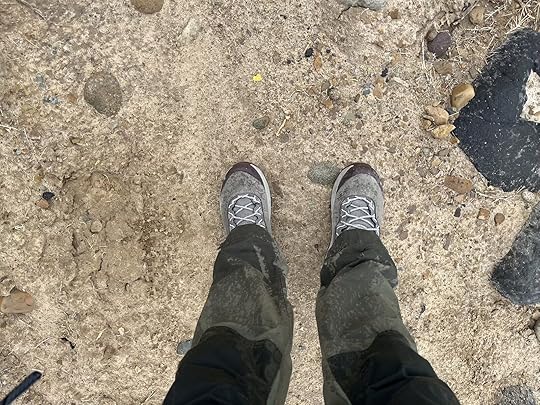
Photo: Tim Wenger
The Cottonwoods are Oboz’s most responsibly sourced hiking boots to date, featuring some 100 percent recycled elements like laces and webbing. Oboz uses gender-specific lasts to address the anatomical nuances between different types of feet. Here are the general specs for men’s and women’s options:
LWG Gold ISA LITE Nubuck LeatherAbrasion-resistant meshPFC-free DWR finishRecycled laces and webbingACTEco Midsole: A proprietary compression molded EVA that adapts to varying terrainTrail Tread Rubber outsoleWaterproof and breathable B-DRY membraneNo-sew overlaysMolded rubber toe capRemovable O FIT insoleHeel drop: 8mmWeight: 13.0 oz / 369g (women’s), 15.6 oz / 442g (men’s)Price: $165 More like thisTravelYour Outdoor Gear Will Soon Be Circular. Meet the Brands Making It Happen
More like thisTravelYour Outdoor Gear Will Soon Be Circular. Meet the Brands Making It Happen
Coolest libraries in the world

While your municipal library might have white walls and garish carpet, be furnished with nothing fancier than metal shelves, and be equipped with loud and ugly electronic checkout systems, and printers, it’s not the case of all libraries. Many libraries around the world are built to impress and be as grandiose as the volumes they host. The coolest libraries in the world have extraordinary architecture, display amazing art, and hold tens of thousands of books, some of them incredibly rare, and the best part is: You can visit most of them.
The 10 coolest libraries around the worldThe Old Library at Trinity College, Dublin, Ireland, home to a 1,200-year-old manuscript
Photo: STLJB/Shutterstock
Trinity College’s Old Library might be most famous for housing the Book of Kells, the ninth-century illuminated Gospel manuscript that is considered one of Ireland’s national treasures, but there’s much more to this library than one ancient (albeit beautiful and incredibly rare) book. The Long Room of the Old Library, the most famous part of Trinity College, is located upstairs from the exhibition room where the Book of Kells is displayed. It is a superb room filled with oak bookcases containing 200,000 of the library’s oldest books that seems to stretch for miles under an barrel-vaulted ceiling.
How to visit the Old Library at Trinity College?
The Old Library is open to the public through a variety of experience packages that range in price from $21 (€19) for a self-guided visit of the Long Room and the exhibition of the Book of Kells, to $37 (€33.50) for a guided tour of Trinity campus, followed by a self-guided visit of the Old Library, the Book of Kells exhibition, the Gaia exhibition, and the immersive digital experience in the Old Library.
The Bodleian Library, Oxford, England, one of the oldest libraries in Europe
Photo: agsaz/Shutterstock
There is some confusion about what the Bodleian Library is. Many people think it’s the Radcliffe Camera, the impressive Baroque 18th-century circular building that is arguably the most recognizable structure in all of Oxford. But it isn’t. The Radcliffe Camera is indeed home to a working library, but it’s not the Bodleian Library. The Bodleian Library is actually officially known as the Bodleian Old Library so as not to confuse it with the Bodleian Library Complex which consists of 26 individual Oxford libraries, including the Bodleian Old Library and the Radcliff Camera. The Bodleian Old Library opened in 1602 and is one of the oldest in Europe. It consists of three beautiful historic rooms: the Upper and Lower Reading Rooms and the Duke Humfrey’s Library. It is connected to the Radcliffe Camera by the Gladstone Link, a underground library/study space.
How to visit the Bodleian Old Library?
30, 60, or 90-minute guided tours of the Bodleian Old Library are available starting at $13.10 (£10). Some tours include visits of the Radcliffe Camera and the Gladstone Link.
Admont Abbey Library, Austria, known as the Beauty and the Beast Library
Photo: Nat S. Retsu/Shutterstock
The Admont Abbey Library, completed in 1776 in a seriously overwhelming European Baroque style, is the largest abbey library in the world. The library’s seven vaulted domes are decorated with stunning frescoes by Bartolomeo Altomonte. Stored below are about 70,000 volumes (the Abbey owns nearly 200,000 books in total) among numerous carvings, pink marble columns, and a striking white and gold aesthetic. In 1865, a fire consumed almost the entire monastery, with the exception of the stunning abbey library and its beautiful and rare volumes. The Admont Abbey Library is said to have been the inspiration for Belle’s library in the 1991 Disney film Beauty and the Beast.
How to visit the The Admont Abbey Library?
The Admont Abbey Library is open to the public. Admission is $20.50 (€18.50) and audioguides are available for $4.50 (€4.00). Guided tours are available daily for just $3.30 (€3) but only in German.
The library at St. Catherine’s Monastery, Egypt, the oldest continuously operated library in existence
Photo: Melnikov Dmitriy/Shutterstock
St. Catherine’s Monastery, built between the years 548 and 565, is one of the oldest monasteries in the world and a UNESCO World Heritage site. It is located in the Sinai Desert, at the foot of Mount Horeb/Mount Sinai, where the Old testament says that Moses received the Ten Commandments from God. The monastery consists of various buildings, including many churches, ossuaries, a 12th-century mosque, accommodations for the residing monks, and what is said to be the oldest continuously operated library in existence. The library at St. Catherine’s Monastery houses thousands of volumes in various languages, including Greek, Georgian, Coptic, Armenian, Ethiopic, and more. The library holds the second-most number of manuscripts (religious and non-religious) after the Vatican.
How to visit the library at St. Catherine’s Monastery?
While various parts of the monastery are open to the public, the library isn’t unless you obtain special permission.
Bibliothèque Nationale de France, Paris, France, home to more than 9,000 comics
Photo: Allen.G/Shutterstock
The Bibliothèque Nationale de France (also known as the BNF) consists of five locations, four in Paris and one in Avignon in the south of France. While they all have their own unique aesthetics, the most beautiful of the five sites is arguably Richelieu, a library-museum combo located in a former 17th-century palace whose renovation was completed in 2022 after more than 10 years of work. Every corner of the BNF Richelieu is worth visiting, from the garden to the grand staircase, but the Oval Room with its 20,000 volumes and 9,000 comic books, the Labrouste Room, and the Mazarin Gallery are the highlights.
How to visit the Bibliothèque Nationale de France — Richelieu?
While the Oval Room (and all its books) is free to access to everyone, other parts of the BNF, including the museum, require the purchase of a ticket. Guided tours are available starting at $10 (€9).
The Stockholm Public Library, Sweden, an unsuspected temple of knowledge
Photo: Thorir Ingvarsson/Shutterstock
The City Library in Stockholm may look very modern, but it opened almost 100 years ago, in 1928. Although it features a border of what looks like hieroglyphics, the exterior of the library is simple enough (a cubic base topped with a cylinder) and does not necessarily catch the eye of unsuspecting out-of-towners. However, those who make it inside get rewarded for their curiosity. Walk in the entrance hall and take the time to admire the stucco relief displaying illustrated extracts from Homer’s Iliad. Then, take the stairs all the way to the Rotunda, the central part of the library. The walls of this large cylindrical room are lined with bookshelves holding 40,000 books. Walk to the top gallery for a stunning view of this unique structure.
How to visit the Stockholm Public Library?
There’s no entry fee to get in, but because it is a functioning library, you’ll have to be silent during your visit. Note that the Stockholm Public Library is closed for renovations until 2027.
Stuttgart City Library, Germany, an ultra-modern structure
Photo: Preisler/Shutterstock
Designed by Korean architect Eun Young Yi and opened in 2011, the city library on Mailänder Platz in Stuttgart might look like an sad-looking gray concrete cube from the outside, but inside, it’s another story entirely. The central room, mostly white, lined with books, and filled with light thanks to an immense skylight, consists of five minimalist floors/galleries all linked by floating staircases. At the top is a roof terrace with sweeping views over the city. The city library on Mailänder Platz in Stuttgart is the city’s Central Library. The Stuttgart City Library complex consists of the Central Library, 18 district libraries, library buses, and the eLibrary. The Central library holds over half a million media items.
How to visit the Central Library in Stuttgart?
Access to the library is free of charge. Upon entering, visitors can borrow audio guides to get a guided tour of this ultra-modern structure and better understand Eun Young Yi’s architectural intents.
Strahov Monastery Library, Prague, Czech Republic, home to thousands of editions of the Bible
Photo: Maciej Bledowski/Shutterstock
The Strahov Monastery Library, part of the Starhov Monastery, is comprised of three main rooms: the Theological Hall, the Philosophical Hall, and the Cabinet of Curiosity, all of which contain invaluable volumes. The Theological Hall stores 21,000 volumes, many of which are different editions of the Bible or parts of the Bible in many languages, and the Philosophical Hall houses over 60,000 volumes on the topics of philosophy and the sciences. Both the Theological and the Philosophical Halls are intricately decorated in a Baroque style with religiously inspired frescoes, stucco work, wooden shelves, and parquet. The Cabinet of Curiosities contains books, as well as glass cases displaying natural science collections, including various fauna specimens and archeological findings. The Theological hall houses a collection of terrestrial and astronomical globes.
How to visit the Strahov Monastery Library?
Admission to the Strahov Monastery Library costs $6.50 (150 CZK). A more complete guided tour of the monastery costs $12.75 (290 CZK). Tickets can be purchased online.
Al-Qarawiyyin Library, Fez, Morocco, one of the oldest libraries in the world
Photo: abdozaghloul/Shutterstock
Morocco’s University of Al-Qarawiyyin library, located in the ancient city of Fez, was founded in the ninth century, making it one of the oldest libraries in the world. (the university itself holds the Guinness World Record for the oldest existing, and continually operating educational institution in the world.) The Al-Qarawiyyin library underwent much-needed extensive renovations which were completed in 2016. The work included restoring the tilework that covers the walls and floors, as well as installing equipment to preserve the many precious volumes the library houses, including a ninth-century Quran.
How to visit the Al-Qarawiyyin library?
While upon the completion of the renovations it was hoped that the library would be open to everyone, because the complex is also home to a mosque, it is currently only open to Muslim visitors.
Real Gabinete Português de Leitura, Rio de Janeiro, the largest library of works by Portuguese authors outside of Portugal
Photo: Diego Grandi/Shutterstock
The Real Gabinete Português de Leitura, which translates as the Royal Portuguese Cabinet of Reading, was initially built to be used as the headquarter for the Portuguese cultural centers of brazil. The impressive library was designed by architect Rafael da Silva e Castro and built between 1880 and 1887 in a style known as neo-Manueline, a Late Gothic architecture of Portugal. It became a public library in 1900. Today, the magnificent shelves of the Royal Portuguese Reading Room house “the largest and most valuable library of works by Portuguese authors outside of Portugal”, including several rare works from the 16th century, the official website says.
How to visit the Real Gabinete Português de Leitura?
The Real Gabinete Português de Leitura is accessible to all, free of charge.
The five best libraries in the USThe Boston Athenaeum, Boston, a National Historic LandmarkView this post on InstagramA post shared by Boston Athenaeum (@bostonathenaeum)
Founded in 1807, the Boston Athenaeum is among the oldest and most distinguished independent libraries and cultural institutions in the US. It added an art gallery in 1827, began running yearly exhibitions of American and European art, and by the mid-1800s found itself not only at the center of Boston’s culture scene but also one of the largest libraries in the country. Overlooking the Granary Burying Ground, the final resting place of Paul Revere and Samuel Adams, it currently houses over half a million volumes, many of which focus on Boston history. It also hosts an exhibition program, lectures, and even concerts, and in 1965, it was designated as a National Historic Landmark.
How to visit the Boston Athenaeum?
The Athenaeum is a membership-only library with annual membership fees starting at $325, and day membership fees of $40, but it’s open to the public. A self-guided tour of the gallery exhibition, art and special collections installations, and the first floor of the library costs $10. Guided tours are available for groups.
Library of Congress, Washington, DC, the world’s largest library
Photo: Sean Pavone/Shutterstock
The Library of Congress consists of three buildings located on Capitol Hill: the Thomas Jefferson Building, the James Madison Memorial Building, and the John Adams Building. All three buildings house a total of 173 million items, including 51 million books and 5.6 million maps. The most impressive of all three buildings is the Italian
Renaissance-style Thomas Jefferson Building completed in 1897. The Main Reading Room, located on the second floor, is the highlight of the library. The first floor is home to the library’s most prized possession: The Gutenberg Bible dating back to the mid-1450s.
How to visit the Thomas Jefferson Building?
You need to book a free timed-entry tickets online to access the Thomas Jefferson Building. Make sure to check out the opening hours for the Main Reading Room before you book your ticket as they might differ from the building’s opening hours.
The Boston Public Library, Boston, the first large free municipal library in the United States
Photo: eskystudio/Shutterstock
The Boston Public Library consists of 25 branches across the city, but the one you want to visit is the Central Library in Copley Square. The Central Library is comprised of two buildings, the McKim building, completed in 1895 and a National Historic Landmark since 1986, and the Boylston Street Building opened in 1972. The McKim building is the most beautiful of the two, and Bates Hall, the gorgeous reading room located on the second floor, is the highlight of this magnificent library.
How to visit the Central Library in Copley Square, Boston?
The library is open daily and entrance is free for all. Free Art & Architecture public tours are offered six times per week on a first come, first served basis.
The Beinecke Rare Book and Manuscript Library, New Haven, one the world’s largest library devoted to rare books and manuscripts
Photo: Jose L Vilchez/Shutterstock
Part of Yale Unversity Library, the Beinecke Rare Book and Manuscript Library, with its simple yet striking geometric exterior, opened in 1963. To protect the rare volumes inside, instead of glass windows, the entire building features square panels of very thin marble that filters the light gently. Of course, that means that the interior of the library is very dark and atmospheric. Visible upon entering, a six-storey glass tower of books makes the core of the building. At the mezzanine level, visitors can admire some of the most prestigious books in the library’s collections, including the Gutenberg Bible and Audubon’s Birds of America.
How to visit the Beinecke Rare Book and Manuscript Library?
The Beinecke Rare Book and Manuscript Library is open to all, for free, during regular hours of operation.
The Seattle Public Library, Seattle, an architectural gem of massive proportions
Photo: Stephanie Braconnier/Shutterstock
The Seattle Public Library has 27 locations, the most striking of which is the Central Library. Opened in 2004, the Central Library is as impressive from the outside as from the inside. The exterior is angular, like a roughly cut diamond, and principally made of glass and steel. Inside, it’s immense: 11 light-filled floors home to a book spiral and a 275-seat auditorium, among many other spaces.
How to visit the Central Library in Seattle?
The Central Library in Seattle is open to all, for free, during regular hours of operation.
What is the oldest library in the world?Both the library at St. Catherine’s Monastery in Egypt and the Al-Qarawiyyin Library in Fez, Morocco, claim to be the world’s oldest library. However, according to the Guinness Book of Records, it is the library at St. Catherine’s Monastery, located in Egypt’s Sinai Peninsula that is officially the oldest library still in operation. Morocco’s University of Al-Qarawiyyin, of which the library is part, holds the Guinness World Record for the oldest existing, and continually operating educational institution in the world.
What library has the most rare books?The Beinecke Rare Book and Manuscript Library in New Haven, Connecticut, houses more than one million books, and millions of other printed materials and objects, making it the largest repository of rare books in the world. The Thomas Fisher Rare Book Library in Toronto, Canada, holds around 700,000 volumes. 
The One Simple Tool Every Traveler Should Be Using More

You never know what type of weather you’re going to get in the mountains. It’s a fact I’ve come to embrace since moving to Denver in 2021. On the last prime-season camping trip in 2024, back-and-forth weather was top of mind as it went from blazing hot, to chilly, to lashing rain, to high-30s at night around Colorado’s Green Mountain Reservoir near Silverthorne.

Photo: Nickolaus Hines
Still, the in-between bouts of sunshine left plenty of time for kayaking, hikes, and exploring. The area is blessedly devoid of service. Though as someone who likes to learn about a place through its plants — native, introduced, or invasive, they all tell a story — this did present one problem: I couldn’t quickly identify what I was seeing. However, my iPhone’s Visual Look Up tool made it easy to do so on the drive back.
Apple released Visual Look Up in the spring of 2024. It’s one of my favorite uses of machine learning to come out this year, and has proved its worth countless times on trips near and far this year.
The technology is complicated, but the concept is simple. Photos saved on an iPhone’s camera roll, either a screenshot or a picture taken on the phone, has an info button. If the phone analyzes the content of the picture (as long as it’s running iOS 15 or later) and can identify what’s depicted, it can be immediately looked up. The icon might change to a paw print, indicating an animal was identified, or a leaf, for a plant. Tapping that icon when service is available will identify what’s in the picture, including the dog breed, plant species, landmark, or any other important information.
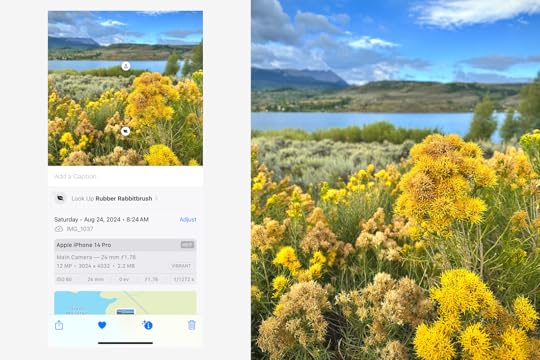
Photo: Nickolaus Hines
This isn’t exactly new-to-the-world tech. I previously relied on plant identification apps to do the same for plants, and then Google Lens (and before that, physical books). Apple puts it all in one place, though. Visual Look Up isn’t topic-specific like the plant ID apps, and I’ve pretty much abandoned Google Lens in recent months for the more reliable information Apple gives.
You don’t have to be a plant nerd or feel the draw to be able to name every dog breed you see for Visual Look Up to make your travel more fulfilling. Seeing a place is one thing, but learning about that place and what has shaped it is really what makes travel worth the unavoidable inconveniences that come along with any journey.
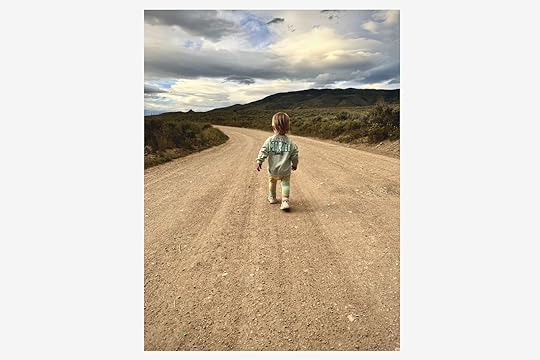
Photo: Nickolaus Hines
For me, that means being able to describe to my toddler exactly what type of flower she is obsessed with at the moment (and being able to tell if it’s safe to pick and tuck in her hair). The same goes for identifying various bugs she tries to pick up, or the history of some obscure landmark with a plaque rendered unreadable by time and the elements.
Travel is all about immersing yourself in what makes a place different from anywhere else. Even sterile resorts that feel like they could be anywhere have interesting features that can tell a story of the way that people and ideas move around the world. Digging deeper and doing some research leads to much more fulfilling trips. The first step to doing so can be as simple as taking a picture and diving into an identification rabbit hole. 
Where to Play, Eat, and Stay in Houston

Houston is a hub for many things: the energy industry, space exploration, a varied food scene, all kinds of arts, and sports, to name a few. But what stood out to me during my recent August visit was the feeling that it’s a city where anyone can feel at home. Not only is Houston the largest city in Texas and the fourth largest city in the United States, but according to a 2024 WalletHub ranking, it’s also the most diverse major city in the country and America’s fourth most diverse city overall. That means there’s lots of cool things to do and inspiring people to meet.
Whether you’re in town to explore the city’s arty side, catch a ball game, experience world-class cuisine, or relax in style, Houston promises a visit you won’t soon forget. Here are some of the best things to do, places to eat, and where to stay when you go.
Things to do in HoustonWander around The Post
Photo: Mark Taylor Cunningham/Shutterstock
The Post, or POST Houston, used to be a post office (specifically, the Barbara Jordan Post Office, named after the first Black senator elected in Texas since Reconstruction). It’s since become an urban redevelopment project with spaces for culture, food, events, and coworking, as well as a rooftop park and farm called the Skylawn from where you can see panoramic views of the Houston skyline. Inside is a mix of dining options, including international options like the West African fare at ChopnBlok, bars, and ice cream stalls. The Post also hosts events like live music, art exhibitions, and pop-up markets, so be sure to see what’s on while you’re in town.
Post Houston: 401 Franklin St, Houston, TX 77201
Snap the street aesthetic at Graffiti Park
Photo: Bonnibelle Chukwuneta
Graffiti Park, also known as the Houston Graffiti Building, is an outdoor art space showcasing murals and creativity from the city’s street art community. It’s in the heart of Houston and is a testament to talented artists who use the walls as their canvas. The artwork is frequently updated, making for a unique experience each visit. Designs include abstract pieces, cultural icons, and tributes, including one for Kobe Bryant. Remember to bring your camera.
Graffiti Park: 1503 Chartres St, Houston, TX 77003
Watch the Astros at Minute Maid Park
Photo: Javen/Shutterstock
Attending an Astros baseball game at Minute Maid Park is a quintessential Houston experience. The park is located downtown, and the stadium is known for its historic train features and retractable roof. I got to see both at a game the Astros won, cheered on by a hive of buzzing fans sporting orange and black, followed by a fireworks show. Minute Maid Park also has several amenities and food options on site, including traditional ballgame fare like hot dogs and nachos, as well as gourmet options like Cajun étouffée nachos, roasted vegetables, and pumpkin-flavored chicken wings at the exclusive Gallagher Club.
Minute Maid Park: 501 Crawford St, Houston, TX 77002
Catch an event at NRG Stadium
Photo: Bonnibelle Chukwuneta
NRG Stadium is Houston’s venue for significant events; it hosted both Beyoncé’s Renaissance Tour and Taylor Swift’s Eras tour during their Houston stops. It’s also home to the Houston Texans if you’re a football fan and want to catch some NFL action while you’re in town. I watched a different kind of football during my visit: a Leagues Cup soccer match between Lionel Messi’s Inter Miami and Tigres, a club from the Mexican Premier League. Messi didn’t play or attend due to an injury, but the game and crowd buzzed with excitement nonetheless.
NRG Stadium: 3 NRG Pkwy, Houston, TX 77054
Take a swing at PopStroke
Photo: Bonnibelle Chukwuneta
PopStroke is an entertainment venue in Katy, a city west of Houston proper in the Greater Houston metropolitan area. The franchise was designed in part by Tiger Woods and offers a modern twist on the traditional mini-golf experience by presenting courses that mimic actual greens. This PopStroke has two 18-hole putting courses that cater to all skill levels. The venue also has a lively atmosphere and dining area, craft beer on tap, and an extensive menu, including yummy appetizers and hand-scooped ice cream.
PopStroke: 23110 Grand Cir Blvd, Katy, TX 77449
Where to eat and drink in HoustonChopnBlok
Photo: Bonnibelle Chukwuneta
Located in POST Houston, ChopnBlok is a fast-casual spot with a menu that celebrates West African specialties, including jollof rice, stewed plantains, and meat pies. It also offers East African fusion in the form of coconut curry. You can’t miss the smell of traditional African spices wafting through the restaurant, plus the Afrobeats bangers in the background.
ChopnBlok: 401 Franklin St Suite 1450, Houston, TX 77201
Bludorn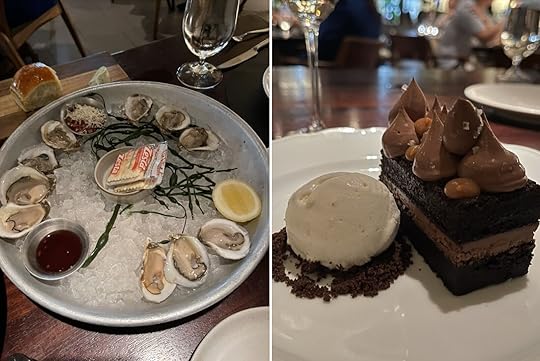
Photo: Bonnibelle Chukwuneta
Equal parts chic, modern, and approachable, Bludorn is one of Houston’s trendiest restaurants. Chef Aaron Bludorn helms the kitchen, turning out modern, French-inspired fare with an emphasis on seasonal and locally sourced ingredients. Start with oysters however you like them — raw, fried, roasted, or smoked — followed by mains like branzino with étouffée or dry-aged duck with rice pilaf. The wine and cocktails list is also impressive, and there are plenty of delicious mocktails to choose from if you don’t partake.
Bludorn Restaurant: 807 Taft St, Houston, TX 77019
Koffeteria
Photo: Bonnibelle Chukwuneta
Located in the heart of East Downtown, Koffeteria is a cool, quirky bakery and cafe that embodies the personality and energy of Pastry Chef Vanarin Fuch. His pastries and desserts are anything but ordinary, with yummy fusion pastries like pho kolaches and black sesame salted egg yolk mochi pushing culinary boundaries while paying homage to Cambodian roots. You can also find specialty drinks at Koffeteria, such as the Salty Cambodian (a latte with butter, sweetened condensed milk, and Maldon salt) and the Salted Lemon Soda, which is perfect if you want a refreshing drink to beat the heat.
Koffeteria 1110 Hutchins St, Houston, TX 77003
Luv’em LechesView this post on InstagramA post shared by Luv’em Leches (@luvemleches)
Luv ’em Leches is the perfect cure for late-night cravings and sweet tooth satisfaction. It’s located in the East End (though delivery is also an option). While I’m always happy to have traditional tres leches, what stood out to me were the flavors that Luv ’em Leches offers. The cakes have plenty of leche and come in various flavors, including piña colada, Reese’s peanut butter, and strawberry.
Luv’em Leches: 1010 Prairie St, Houston, TX 77002
Lucille’s
Photo: Bonnibelle Chukwuneta
Lucille’s is a beloved Houston spot doing Southern comfort food in a sophisticated way. It’s the place to be for a relaxing breakfast or brunch. Lucille’s is located in the Museum District in a vintage-style building that pays tribute to owners Chris and Ben Williams’ great-grandmother, Lucille B. Smith. The restaurant is relaxing and welcoming, with must-try dishes like the famous fried chicken and waffles, chili biscuits, and shrimp and grits.
Lucille’s: 5512 La Branch St, Houston, TX 77004
Handies Douzo
Photo: Bonnibelle Chukwuneta
Handies Douzo makes sushi with quality ingredients. It’s a small spot, so the atmosphere is intimate and makes for nice conversation with guests and sushi preparers alike. The simple menu features hand rolls with fresh fish and seafood, including amberjack, yellowtail tuna, and scallops, all perfectly seasoned and made to order in front of you.
Handies Douzo: 3510 White Oak Dr., Suite A, Houston, TX 77007
Where to stay in Houston: Marriott Marquis Houston
Photo: Bonnibelle Chukwuneta
Located in the heart of downtown, a short walk from Minute Maid Park, the Marriott Marquis Houston is a standout choice for a memorable stay. Its rooftop deck is home to the only Texas-shaped lazy river in the world, so you get breathtaking views of the Houston skyline while you relax. There are a number of restaurants to choose from at the hotel, including Walker Street Kitchen (Southern-inspired breakfast and brunch), Biggio’s (a two-story sports bar serving American fare), and Xochi (a Oaxacan culinary experience). There are also a ton of great restaurants nearby the hotel, which gets points for its walkability.
Before you leave, be sure to make time for some pampering. The on-site PureSpa offers facials, massages, and other therapeutic services that are nothing short of bliss. I had a hot stone massage while I visited, and it was one of the better ways to spend some time.
How to get to and around Houston
Photo: Nate Hovee/Shutterstock
Houston has two major airports: George Bush Intercontinental Airport (IAH) and William P. Hobby Airport (HOU). Both airports are well-connected to cities across the US and internationally, making Houston an accessible destination no matter where you’re flying from.
Once you land, you can use a rideshare app, taxi, or airport shuttle to get into the city proper, or you can rent a car. Getting around Houston is pretty straightforward. The city is car-centric, with a vast highway network. I didn’t have the opportunity to try public transportation, but there were bus stops and light rail services a short walk from the Marriott Marquis Houston. Renting bikes and scooters is another popular way to get around Houston. 
The No. 1 Rule For a Successful Road Trip, According to the ‘Amateur Traveler’

Chris Christensen has run the travel blog and podcast Amateur Traveler since 2005. His podcast alone has more than 900 episodes. He’s clearly not an amateur in the sense that he’s new to travel or unpaid for his work, but he is an amateur when you consider the root of the word.
Amateur, Christensen explains on the Matador Network podcast No Fixed Address: The World’s Most Extraordinary People, comes from the same Latin root as amore, meaning love. “And so amateur is to do something for the love of it,” he tells Michael Motamedi and Vanessa Salas.
This “amateur” approach has led to a life full of engaging travel stories that he shares far and wide.
Christensen traveled around the United States growing up. The only other international country he’d been to by the time he graduated college was Canada (he watched the moon landing on a tiny television at a campsite in British Columbia). “It certainly made me love national parks, love traveling, love a good road trip,” Christensen says. Once his kids were older, he started going abroad.
A traveler’s life wasn’t always in the cards. Christensen worked as a software programmer for 42 years, and he initially was going to do a podcast about tech (“I am a nerd by vocation,” he explains). He also did a religious podcast for a year.
Then, “we had some friends over for Memorial Day and all the best stories were travel stories,” Christensen says. “So I said that’s it. I’m starting a podcast. It’s going to be about travel.”
He was traveling four weeks a year at that point, because that’s how much vacation he had, and was putting out more than 40 podcasts a year. He started inviting friend new and old to share their travel stories as well — from Reno to Afghanistan. Other than a few exceptions, each episode is about someone who truly loved a place they visited and had an experience to share.
The goal? That “I’ve helped you use your vacation time well and pick out a destination that is worth your time. It doesn’t matter as much whether it’s my favorite destination or not. It matters whether you’re going to enjoy it.”

Photo: Chris Chistensen
Along the way, he’s learned a few important tips. Top of mind relates to road trips. “What is your number one rule for a road trip? Go with people you like,” Christensen says. “Nothing else matters.”
He also suggests that people set a quest on their trips. That can be seeing a number of UNESCO World Heritage Sites in a region, or going to every ballpark in a country. Micro quests, like finding the best mofongo in Puerto Rico, can also help make travel more fulfilling. One of Christensen’s personal quests is that when he dies, he wants the number of countries he’s visited to be higher than the number of years he lived.
For more about how Christensen built a life around travel, why even anti-cruise people should consider hopping on a ship (the right type of ship), how to pack light, his favorite cities, and more travel tips that help him get around, listen to the full No Fixed Address episode on your favorite podcast platform. 
A New Peru Marine Reserve Protects Rare Whales, Mantas, Penguins, and More

The Grau Tropical Sea National Reserve, in the vast blue expanse off Peru’s far northern coast, is an impressive new addition to the country’s growing network of more than 70 protected areas. The new reserve covers an extensive 300,000 square acres of ocean, making it one of the largest protected marine areas in the region. It’s named after Miguel Grau, a revered Peruvian naval hero, and is an excellent example of the country’s commitment to preserving its rich marine biodiversity. The space also honors the country’s people and culture, as the reserve’s protections extend to the 15,000 families within fishing villages along the coast, many of whom operate from small sailboats and artisanal boats using traditional fishing methods passed down through generations.
The Peruvian government formally announced its intention to create the Grau Tropical Sea National Reserve in 2022, which was met with generally positive support from environmental groups, scientists, and local communities, who saw it as a crucial step towards preserving global biodiversity. The next two years were spent creating management plans and official boundaries for the area, and it officially opened in 2024.
The reserve is home to 70 percent of the country’s marine species
Photo: Peru Travel
The Grau Tropical Sea National Reserve is a haven for a stunning variety of marine species. It’s in the reserve that tropical currents meet the cold Humboldt current, creating a unique and highly productive marine environment full of everything from tiny plankton to giant whales. There’s an extraordinary and array of life, and among the many species that call this reserve home are several that are considered endangered or vulnerable, including sea turtles, humpback whales, and hammerhead sharks. The area is also a crucial breeding and feeding ground for numerous fish species, making it an important zone on a global scale as it supports healthy marine ecosystems across the Pacific Ocean.
Establishing and enforcing the protection rules is important to fight the growing threats of overfishing, climate change, and pollution. Peru’s northern coast was once a hotbed of industrial fishing and now has seen significant depletion of fish stocks over the decades. That has impacted other rare species visitors may find in the area, including giant manta rays and birds like the Peruvian pelican and Humboldt penguin. One goal of the Grau Tropical Sea National Reserve is to reverse this trend by creating a protected area where marine life can recover and thrive. For visitors, that makes the Grau Tropical Sea National Reserve one of the best places in Peru to see rare species and a healthy ecosystem teeming with life at every turn.
Different zones in the Grau Tropical Sea National Reserve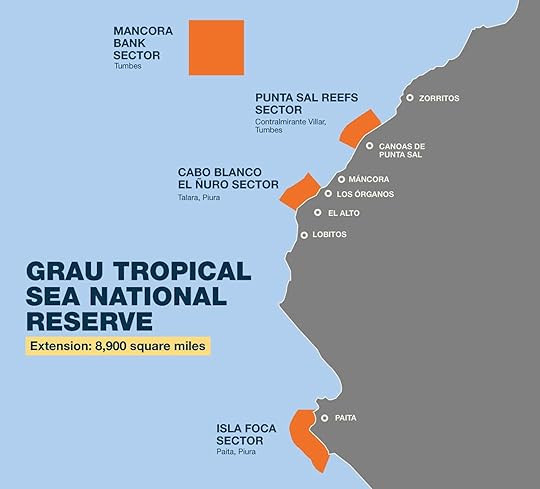
Photo: Peru Travel
The Grau Tropical Sea National Reserve is divided into four separate zones, of which the furthest north section is the largest.
Punta Sal ReefsThe Punta Sal Reefs, located off the coast near the popular beach town of Punta Sal, are one of the most ecologically significant sections of the Grau Tropical Sea National Reserve. The area is known for vibrant coral reefs, a critical habitat for a wide array of marine species, including numerous types of fish, invertebrates, and sea turtles. The reefs are formed by a combination of hard and soft corals, creating a complex underwater landscape that supports high levels of biodiversity. The reefs are also a breeding ground for species that are vital to both the food web and the local fisheries.
The reefs along these section of coast need to be protected as they act as a buffer for the shoreline, protecting areas on land from storms, waves, flooding, and erosion. But key as they are, the reefs face significant threats from climate change, including coral bleaching and ocean acidification. Management within this sector is focused on measures to keep the corals and alive and healthy, while also promoting sustainable activities like snorkeling and diving to both expose travelers to the beauty of the ocean while simultaneously generating tourism revenue.
Cabo Blanco-El Ñuro Sector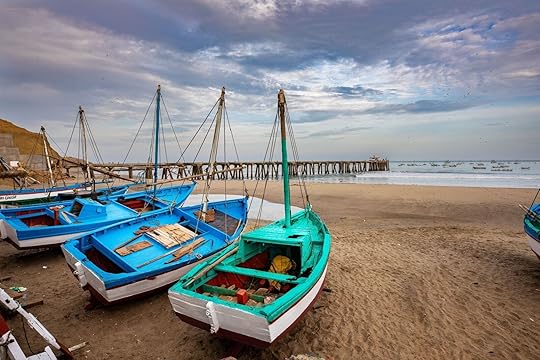
Photo: BETO SANTILLAN/Shutterstok
The Cabo Blanco-El Ñuro sector of the Grau Tropical Sea National Reserve has historically been a hotbed for fishing and sport-fishing, once including notable figures like Ernest Hemingway. It’s closest to El Ñuro, a coastal village with a resident population of year-round green sea turtles. The marine ecosystems in this sector are incredibly diverse, with coral formations, kelp forests, and rocky coastal habitats for a wide range of species. Management in this sector is focused on strict fishing regulations, as well as creating no-take zones to ensure the long-term sustainability of marine life. In this part of the reserve, fishermen and locals are extremely involved in management and economic decisions.
Máncora Bank SectorThe Máncora Bank sector is the furthest out section of the Grau Tropical Sea National Reserve, with deep water and a diversity of species, making it one of the most biologically important areas within the reserve. The area is particularly known for its populations of large pelagic fish, such as tuna and marlin, as well as its importance as a feeding ground for dolphins and migrating whales. Conservation efforts in the Máncora Bank sector are focused on regulating fishing activities to prevent overexploitation, protecting critical habitats, and scientific research, with ongoing studies aimed at understanding the impacts of environmental change on marine ecosystems.
Isla Foca Sector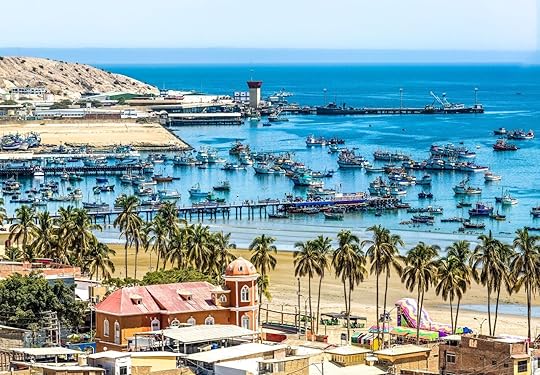
Photo: Christian Vinces/Shutterstock
The Isla Foca sector is a small section off the coast of Piura, near the town of Paita. It’s a refuge for sea lions, dolphins, and numerous species of fish and invertebrates, and the coastal area is a breeding ground for seabirds and boobies that nest on Isla Foca’s rocky cliffs. You can visit the island only on boats, but you’ll need to book a tour through either a local fisherman or the in the small town of La Islilla, which does have a visitor center for the island run by Seacology.
Travel planning and logistics
Humboldt penguins are considered vulnerable and live closer to to the southern areas of the reserve. Photo: Daniel Lamborn/Shutterstock
Visiting the Grau Tropical Sea National Reserve is absolutely possible, but requires just a little more effort than a quick tourist trip to a city like Lima. The reserve is accessible from several coastal towns in northern Peru, with the most popular entry points being the cities of Piura and Tumbes. From these hubs, you’ll need to arrange transportation to various parts of the reserve, rent a car, or book with a tour operator who can arrange airport transfers. Several tour companies around the coastal towns offer boat trips, whale-watching tours, and more, including Pacifico Adventures and Oceanica Expeditions in Organos (just south of Máncora), or Chelonia Dive Center and Spondylus Mancora for divers.
Máncora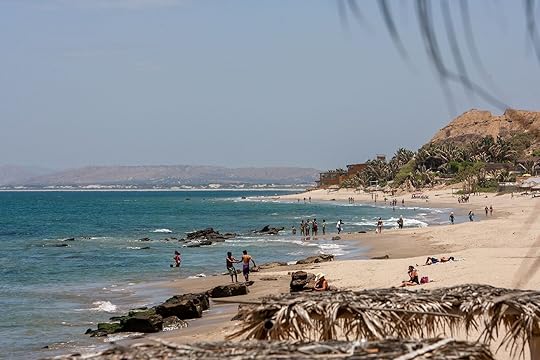
Photo: Beto SANTILLAN/Shutterstock
Máncora is the most popular and well-developed tourist town in northern Peru, famous for its sun-soaked beaches, prime surfing conditions, and vibrant nightlife; it’s considered a party town among Peruvians. It’s a hub for both backpackers and luxury travelers, with everything from budget-friendly hostels to upscale beachfront resorts. Many hotels and resorts in Máncora have leisure amenities like swimming pools, spa services, and direct beach access, making it a popular choice for travelers who want to location for those looking to relax by the ocean. But you’ll still find plenty of affordable options.
Visiting the Grau Tropical Sea National Reserve from Máncora is relatively easy, as the town serves as a convenient starting point for tours and excursions into the reserve, particularly to the Máncora Bank sector. Local tour operators offer guided trips that include activities such as snorkeling, diving, and whale watching, as well as eco-focused tours focusing on marine conservation and the sustainable practices of local fishermen. Getting there is easy, as there are several direct flights per day from Lima to Tumbes, which is about a 60-mile drive from Máncora.
Cabo Blanco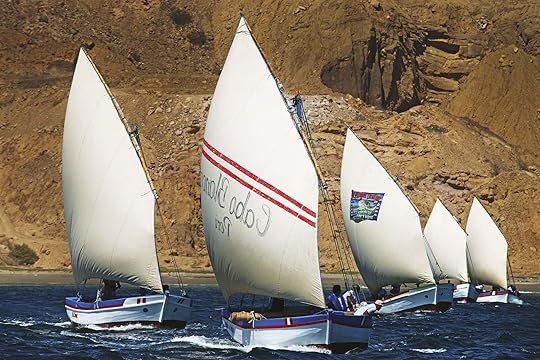
Photo: Peru Travel/Walter H. Wust
Cabo Blanco is a small fishing village steeped in the culture and lifestyle of fishing, and is where Ernest Hemingway visited in the 1950s when they were filming the movie adaptation of The Old Man and the Sea. Today, it continues to draw visitors interested in both its historical significance and its fishing opportunities. Cabo Blanco retains much of its old-world charm, with modest accommodations that reflect the town’s fishing heritage. Most lodging options are small guesthouses or boutique hotels, many with lovely views of the Pacific Ocean. It’s a quieter, more low-key atmosphere than Máncora.
When to visit the reserve
Photo: Peru Travel/Walter H. Wust
The best time to visit the reserve is during the dry season, which runs from May to November. Those months have more predictably pleasant weather and generally calmer sea conditions, making it a better time for water-based activities such as diving and snorkeling. The dry season is also the best time to see migrating humpback whales, who pass through the area between June and October. During the off-season, availability for tours and hotels may be more limited.
How to get thereGetting to the northern part of Peru usually requires one extra flight from Lima, and some driving. From Lima, you’ll want to fly to Aeropuerto Internacional de Chiclayo in Chiclayo, then drive about three hours to Piura, or fly to Cap. FAP Pedro Canga Rodríguez Airport in Tumbes, then drive two hours south to Máncora. More like thisWildlifeHow to See Giant Andean Condors at Peru's Colca Canyon
More like thisWildlifeHow to See Giant Andean Condors at Peru's Colca Canyon
Matador Network's Blog
- Matador Network's profile
- 6 followers



